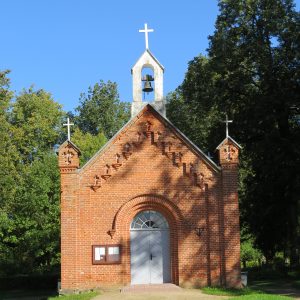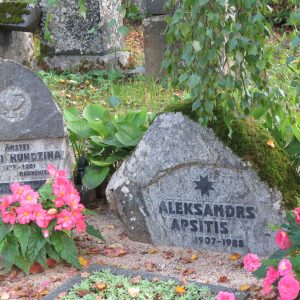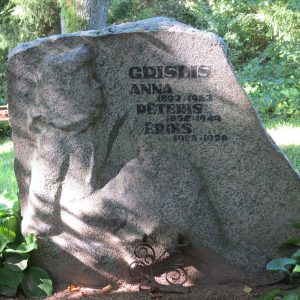Rauna Cemetery
Rauna cemetery was consecrated on 29 June 1773, when pastor Michael Wurm was in office. Land plots for the needs of the cemetery were gifted by the owner of Rauna Castle Manor – Count Grigory Orlov (1734–1783). Before that, the cemetery was situated next to Rauna Church.
Several notable people have been buried at Rauna Cemetery and a considerable number of artistically valuable gravestones and metal crosses can be found there. One of the pioneers of modern pharmacy and the founders of modern bacteriology in Russia Kārlis Krēsliņš (1860-1929), whose memorial stone is made in Art Nouveau style by sculptor Gustavs Šķilters, is buried at Rauna Cemetery. The pastor of Rauna congregation, teacher and author of textbooks Ādams Jende (1861-1918) is buried at the cemetery. His memorial stone has been made by sculptor Kārlis Zemdega. A merchant Pēteris Rimša (1853-1908), whose memorial stone was made by sculptor Gustavs Šķilters, is also buried at the cemetery.
The first Rauna Lutheran congregation pastor, Latvian, Krišjānis Dzirne (1829 – 1896), Baltic German pastor Michael Wilhelm Wurm (1715-1795), the Head of Cēsis Teachers’ Society, a teacher awarded with the Order of the Three Stars Pēteris Neijs (1862-1935), author of multiple Christian books and Rauna congregation pastor Arvīds Treicis (1902-1944), who died during the World War II, physician of Rauna Rūdolfs Skaidrais (1882-1954) and his wife, physician, Elza Skaidrā (1900-1989), radio industrialist, founder of the factory “A.Apsītis un E.Žukovskis” Aleksandrs Apsītis (1907-1988), Rauna congregation school teacher and active social figure Eduards Auka (1871-1941), holder of the Military Order of Lāčplēsis – Artūrs Milnis (1900-1941), Pēteris Sautiņš (1891-1968), Jānis Zvirbulis (1896-1938), decriptor of the handwritings of Rainis and Aspazija – Aina Leite (1922-2005), graphic artist, painter and the author of “Raunas miniatūras” (Rauna Miniatures) Indulis Gurtiņš (1925 – 1991), famous psychotherapist Jānis Zālītis (1933-2007), historian and researcher of Rauna history Sarma Ruska (1941-2010), biology scientist Milda Krūklande (1909-2002), sculptor Biruta Grīsle (1927 – 2004) are also buried at the cemetery, as well as family graves of the owners of Baižkalns Manor Estate – Zuckerbecker family.
The oldest grave cross found at the cemetery with flat decoration in flower shape at the tips of the cross has been installed for people, who died in 1825 – 1834. Several other artificially valuable forged metal objects – three large – 2-3 m high crosses, 118 crude iron crosses of different type, 14 crude iron benches, 5 crude iron lace fences, 7 crude iron chain fences, etc. In 2000, a monument for the victims of Red terror was installed at Rauna Cemetery.
Gallery
Travel objects
- Rauna Castle
- Rauna Castle Courtyard
- Rauna Park and Rauna Manor Estate
- Rauna Evangelic Lutheran Church
- Rauna Agricultural Society House
- Rauna Freedom Monument
- Rauna Mill
- Strads Pub / Rauna Dairy
- Plūme House / Bookshop
- Rauna Parish House
- Rauna Congregation School / Office of Sarkanais Oktobris Collective Farm
- Rauna Devil’s Cave
- Rauna Staburags (Staburags Cliff of Rauna)
- Jānis Cimze Monument
- Rauna “Pārupe” (Left Bank)
- Baižkalns Manor Estate
- Lauktehnika (Agricultural Equipment Station)
- House of Doctor’s Skaidrais Family / House of psychotherapist Jānis Zālītis
- Rauna Hospital
- Rauna Post Office
- Rauna Pastor’s Manor
- The Centre of Rauna and the visit of USSR leader Nikita Khrushchev
- Rauna Cemetery
- Cemetery of Soviet Soldiers, who Died during the World War II
- Rauna Castle Tower
- Intermediate Passages of Rauna Castle
- Rauna Castle Plastering
- Heating and Smoke Channels of Rauna Castle






